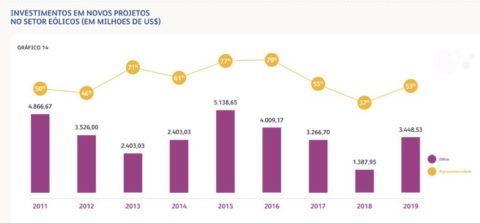Wind power is already the second largest source in the Brazilian energy matrix. According to the Brazilian Wind Energy Association (ABEEólica), the installed capacity in the country reached 16 GW in the first half of 2020. There are 637 wind farms and 7,738 wind turbines.

In 2019, the wind power industry invested R $ 13.6 billion in Brazil, according to data from Bloomberg New Energy Finance (BNEF). Wind power generated 55.9 TWh, 15% more than in 2018.
On a monthly average, it is enough to supply 28.8 million households per month in 12 states. This is equivalent to a population of 86.3 million people, considering three inhabitants per household.
What is eolic energy?
Wind energy is produced from moving air masses, that is, the wind. It is used by converting the translational kinetic energy into rotational kinetic energy.
Advantages of wind energy.
The socio-economic and environmental benefits of wind power come from the fact that it is renewable and has a low impact on its installation and operation sites.
Since wind farms do not emit CO2, in 2019 alone, emissions of 22.85 million tons of carbon dioxide were avoided. According to ABEEólica, the amount is equivalent to the annual emission of approximately 21.7 million automobiles.
In addition, it generates income and improves the lives of owners with the payment of leases, which are subject to taxes, for putting more than 7,000 wind turbines into operation.
Production coexists with other activities and allows the owner to continue planting or raising animals. In this way, it also helps to stay in the field and train the local workforce.
Expanding sector in Brazil
The Brazilian electrical matrix is ??made up of hydroelectric (59.6%), wind (9.3%), biomass (8.7%), natural gas (8.6%), oil (5.2%), SHP and CGH (3.5%), coal (2.1%), photovoltaic (1.7%) and nuclear (1.2%) solar energy.
This balance gathers data from ABEEólica and the National Electric Energy Agency (Aneel), from June 2020.
The development of the wind energy industry in Brazil can be explained by the quality of the Brazilian winds. They are stable, with adequate intensity and without sudden changes in speed or direction.
They have a capacity factor, since it measures the productivity of the wind, above the world average. In 2019, the average global capacity factor was 34%; in Brazil it was 42.7%. During the “harvest of the winds”, from June to the end of the year, there was an average month of 59%.
With more and more wind farms in operation, in 2020, Brazil reached 7th position in the Global Ranking of the World Wind Energy Council (GWEC). The sector estimate is that the country will have around 24.2 GW of installed capacity by 2024, considering auctions already held and contracts signed on the free market.
In an interview on the Association’s official website, ABEEólica’s Executive President, Elbia Gannoum, analyzed how the Covid-19 pandemic affected the sector.
“It is clear that there will be an impact, because the drop in demand was large and this should affect the upcoming auctions in the regulated market, but I still think it is too early to talk about the numbers of this impact, because the free market is moving fast and has grown a lot. “
According to the 2019 Wind Generation Annual Bulletin, considering the representativeness and supply, generation by wind source was responsible for 9.71%, which reached 14.17% at the peak of the wind harvest in August, on average of the total generation injected. in the National Interconnected System (SIN).
Wind energy capture.
The mechanical energy from the rotation of the wind turbine, or wind turbines, drives an electric power generator by a shaft and is then converted into electricity through electromagnetic induction resulting in alternating current.
To implement projects for the installation of a wind farm, it is necessary to produce Environmental Impact Studies (EIA), which are the basis of the Environmental Impact Report (Rima).
These documents detail the actions defined to minimize the possible negative impacts of the activity.
An example is the fact that wind turbines change the local landscape and can also affect the migratory behavior of birds, causing accidents with birds reaching the rotor blades.
Its sound impact must also be considered because the wind, when reaching the blades of the turbine, produces a constant noise. Therefore, they must be installed at least 200 meters from homes or residential areas.


